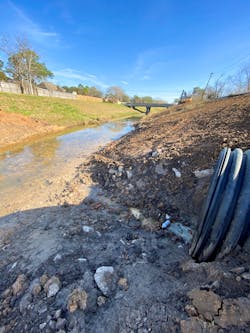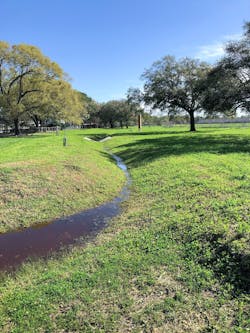How a Texas Utility is Going Back to the Basics to Update SWMP
Houston, Texas, also referred to as the Bayou City, is home to winding waterways that flow through the city. Bayous are normally slow moving, sometimes marshy, waterways that lead to streams, rivers, lakes and bays while providing an eco- system which supports vegetation and wildlife. Houston bayous play a critical role in flood control: collecting stormwater runoff from adjacent urban areas and storing the volume as it flows downstream.
Stormwater runoff is produced by rain or snowmelt, creating runoff sheets that flow over impervious areas such as pavement, roads, building roofs, construction sites and industrial facilities. As the runoff sheets flow over impervious surfaces, it can pick up trash, chemicals, bacteria, fats, oils and grease (FOG) and other pollutants. As the sheet flow travels to water bodies, it carries contaminants, which can prove harmful to streams, rivers, lakes and bays. These harmful impacts can include compromising natural habitat, decreasing bio- diversity, contaminating drinking water sources and the designation of hazardous areas. Urban areas typically have higher concentrations of impervious areas and point sources, and therefore a higher potential for increased contamination.
The Clean Water Act
The Clean Water Act (CWA) is the primary federal law in the United States governing water pollution to maintain and restore the integrity of the nation’s water through regulatory standards. The CWA was enacted in 1972 through amendments to the Federal Water Pollution Control Act.
The U.S. Environmental Protection Agency (EPA) regulates compliance with the CWA and has authorized state programs to handle the permitting and enforcement of discharges through the National Pollutant Discharge Elimination System (NPDES) program. The NPDES program regulates stormwater discharges from three sources: municipal separate storm sewer systems (MS4s), construction activities and indus- trial activities. Entities that discharge from these sources may be required to obtain a permit with intent to reduce or eliminate the potential for stormwater runoff to convey pollutants from these sources to area surface waters. To protect water bodies, best management practices (BMPs) can be implemented to reduce the potential for contamination at the source.
The Importance of MS4s
Enter Municipal Separate Storm Sewer Systems (MS4s) — systems defined as conveyances to ditches, swales, gutters, inlets and storm sewers designed to collect and convey stormwater into waters of the United States. An MS4 is owned and maintained by a state, local governmental or a public entity. The entity is required to implement and enforce stormwater management to ultimately protect water quality. To do so, permits are required. Permits for MS4s are implemented in two phases. Phase 1 includes medium and large systems. Phase 2 includes small systems serving popu- lations less than 100,000 and includes non-traditional MS4s for entities such as hospitals, prisons and colleges.
Managing the Stormwater
In addition to obtaining a discharge permit, permittees must prepare and use a stormwater management program (SWMP). The SWMP must be a developed plan, that is implemented and enforced, and must be continuously evaluated for effectiveness to reduce the discharge of pollutants into the MS4 and to protect water quality. The SWMP describes the goals and best manage- ment practices (BMPs) of the program, consistent with the permit requirements. The SWMP requires BMPs to be developed under the following six categories of minimum control measures (MCM):
- Public education
- Public involvement
- Illicit discharge detection and elimination
- Construction
- Post-construction
- Pollution prevention and good housekeeping
The first MCM, public education, is to provide outreach and educate the MS4s community on the potential of pollution through common activities and behaviors to reduce their potential to contribute to pollution. The second MCM, public involvement, aims to provide opportunities for the MS4s community to develop and implement BMPs, such as clean up events or surveys.
Third, illicit discharge detection and elimination, requires an MS4 to enforce a program to detect and eliminate illicit dis- charges. As part of this program, the MS4 must establish a policy (or other regulatory mechanism) prohibiting illicit discharges, establish enforcement procedures and actions, detect and address illicit discharges (including illegal dumping), and inform the public of the program.The fourth MCM is construction, which describes how the MS4 will regulate and mitigate point sources from construction activities. Typically, during construction activities, vegetation and topsoil are stripped, making the area susceptible to erosion, and the activities performed produce waste.
The fifth MCM is post-construction and describes how the MS4 will regulate to reduce pollutants in stormwater runoff from new and redevelopment. New development can affect water quality because during development, natural landscapes are often replaced by impervious surfaces leading to an increased volume of runoff and the accompanying pollutants. The sixth measure is pollution prevention and good house- keeping, which entails developing and implementing a program to reduce contamination from daily activities and mainte- nance operations. Ultimately, the developed BMPs under each MCM are to be representative of practices that will achieve the goals of the MCM outlined in the permit. The BMPs are developed as actionable goals with an implementation timeline. The SWMP also requires the MS4 to monitor pollutant levels at area discharge points.
MS4s monitor the discharge of pollutants of concern (POC) to impaired water bodies, which are defined as water ways contami- nated by pollutants. If there are discharges to an impaired water body, the permittee must include SWMP controls to target POCs. Monitoring benchmarks of POCs assists in determining the effec- tiveness of the BMPs implemented.
In conjunction with the SWMP, permittees are also required to prepare and submit an annual report that reflects the status of the BMPs, implemented per the SWMP, with quantifiable results.
MS4 in Action: A Case Study
The Clear Lake City Water Authority (CLCWA) is a municipal utility district created by the Texas legislature in 1963. Located in southeast Harris County, 20 miles southeast of downtown Houston, CLCWA is the largest water authority in Texas, serving approximately 90,000 residents over 15,840 acres. The CLCWA is a small MS4 and, under the rules of the Texas Commission of Environmental Quality (TCEQ) and the Texas Pollutant Discharge Elimination System, it may discharge directly to surface water. The current permit, issued in 2019, expires in January 2024. TCEQ is drafting a new, small MS4 General Permit (TXR040000), so the CLCWA is reviewing its SWMP in preparation for the renewal process. The current SWMP includes measures to educate the public by posting water quality and conservation information to their website and social media. In addition, to eliminate illicit dis- charge, the CLCWA offers used vehicle and cooking oil collection.
The CLCWA also has converted a 178-acre golf course to a series of in-line, wet bottom detention ponds to mitigate potential for flooding. The detention facility can detain more than a 500 million gallons of storm water, provides recreation, natural habitats for area wildlife and incorporates multiple water quality improvement features. These features include wetlands installed at the normal water surface elevation, which naturally filter FOG, deep pools that allow for sedimentation of suspended solids, and trash screens that prevent sold waste from traveling downstream. Based on an estimated 2,400-acre detention facility drainage area, approxi- mately 15% of CLCWA’s service area runoff is routed through the detention ponds. The project is an example of how flood control measures can incorporate BMPs for improved water quality.
What is most effective, in developing a SWMP, is to review BMPs in a holistic manner to identify what is already being done, which BMPs are most effective to implement and on what timeline, and to compare the effectiveness to cost. These practices can be incor- porated into the plan if they align with the MCMs.
About the Author
Abby Stanhouse
Abby Stanhouse, PE, is with Lockwood, Andrews and Newnam, Inc. (LAN-inc.com) on the Water District Engineering team in Houston, Texas. Stanhouse is also a project manager for the CLCWA’s Exploration Green Detention Facility project.





